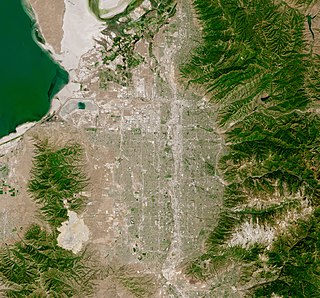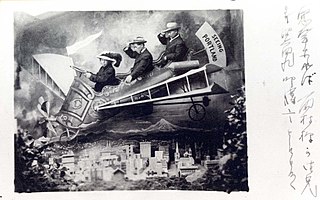
Salt Lake City, often shortened to Salt Lake or SLC, is the capital and most populous city of the U.S. state of Utah. It is the county seat of Salt Lake County, the most populous county in the state. The city is the core of the Salt Lake City Metropolitan Statistical Area (MSA), which had a population of 1,257,936 at the 2020 census. Salt Lake City is further situated within a larger metropolis known as the Salt Lake City–Ogden–Provo Combined Statistical Area, a corridor of contiguous urban and suburban development stretched along a 120-mile (190 km) segment of the Wasatch Front, comprising a population of 2,746,164, making it the 22nd largest in the nation. With a population of 200,133 in 2020, it is the 117th most populous city in the United States. It is also the central core of the larger of only two major urban areas located within the Great Basin.

Federal Heights is a neighborhood in Salt Lake City, Utah. It is generally considered as the residential area to the east of Virginia Street and to the north of South Temple Street in Salt Lake City. It abuts the Wasatch Mountains to the north, and the University of Utah to the south and east. Federal Heights is one of the more affluent neighborhoods in Salt Lake City, with many of the homes in the area dating to the early 20th century.

Temple Square is a 10-acre (4.0 ha) complex, owned by the Church of Jesus Christ of Latter-day Saints, in the center of Salt Lake City, Utah. The usage of the name has gradually changed to include several other church facilities that are immediately adjacent to Temple Square. Contained within Temple Square are the Salt Lake Temple, Salt Lake Tabernacle, Salt Lake Assembly Hall, the Seagull Monument, and two visitors' centers. The square was designated a National Historic Landmark District in 1964, recognizing the Mormon achievement in the settlement of Utah.

The Seagull Monument is a historic monument situated immediately east of the Salt Lake Assembly Hall on Temple Square, in Salt Lake City, Utah. Created by artist Mahonri Young, the monument commemorates an 1848 event in which seagulls were observed to devour crop-destroying Mormon crickets, following prayers for divine intervention against the insects. This event is referred to as the miracle of the gulls in the culture of the Church of Jesus Christ of Latter-day Saints.

Salt Lake City, Utah has many historic and notable sites within its immediate borders. Although the entire Salt Lake City metropolitan area is often referred to as "Salt Lake City", this article is concerned only with the buildings and sites within the official city limits of Salt Lake City.

Elbert Duncan Thomas was a Democratic Party politician from Utah. He represented Utah in the United States Senate from 1933 until 1951. He served as the Chair of the Senate Education Committee, and is the last Democrat to serve as Utah’s Class 3 Senator.

The Conference Center, in Salt Lake City, Utah, is the premier meeting hall for the Church of Jesus Christ of Latter-day Saints. Completed in 2000, the 21,000-seat Conference Center replaced the traditional use of the nearby Salt Lake Tabernacle, built in 1868, for the church's biannual general conference and other major gatherings, devotionals, and events.

Downtown is the oldest district in Salt Lake City, Utah, United States. The grid from which the entire city is laid out originates at Temple Square, the location of the Salt Lake Temple.

Salt Lake City is located in a large valley, the Salt Lake Valley, separated by the eastern Wasatch Mountains, a subrange of the Rocky Mountains, and the Oquirrh Mountains to the west. Salt Lake City is located at 40°45'17" North, 111°53'33" West.

The Salt Lake City Cemetery is a cemetery in northeastern Salt Lake City, Utah, United States, that is one of the largest city-operated cemeteries in the United States.
Anime Banzai was an annual three-day anime convention held during October at the Davis Conference Center in Layton, Utah. The name of the convention roughly comes from the Japanese word for "hooray". The convention is organized by Utah Anime Promotions and was run by a volunteer staff.
Utah is a state in the Mountain state subregion of the Western United States with a population of 3 million people. Originally populated by the Ancestral Puebloans, Ute, Navajo, and Fremont people, Utah has experienced several waves of immigration over its history, leading to a diversity of ethnic and national backgrounds. Historians characterize the post-Indigenous settlement of Utah as having occurred in three major waves, the first between 1850 and 1880, the second between 1880 and 1920. and the third post World War II to the present.
The Alta Club is a private club in downtown Salt Lake City, Utah, named for a local mining district. It was founded in 1883, 13 years before Utah's accession as a state. The Alta Club serves as a forum for business development and social interaction, and offers facilities for dining, social events, business meetings, and health and wellness.

The Salt Lake City Intermodal Hub, also called Salt Lake Central station by the Utah Transit Authority (UTA), is a multi-modal transportation hub in Salt Lake City, Utah, United States served by the Blue Line of UTA's TRAX light rail system that operates in Salt Lake County and by the FrontRunner, UTA's commuter rail train that operates along the Wasatch Front with service from Ogden in central Weber County through Davis County, Salt Lake City, and Salt Lake County to Provo in central Utah County. Service at the intermodal hub is also provided by Amtrak, and Greyhound Lines, as well as UTA local bus service.

The Brigham Young Monument is a bronzed historical monument located on the north sidewalk of the intersection at Main and South Temple Streets of Salt Lake City, Utah. It was erected in honour of pioneer-colonizer, Utah governor, and LDS Church president Brigham Young who led the Mormon pioneers into the Utah Territory in 1847. The base of the twenty-five-foot monument has the bronze figure of an Indian facing east and that of a bearded fur trapper facing west, both of which preceded the Mormon settlers. On the south side is a bronze bas-relief of a pioneer man, woman, and child, while another bronze plaque has a list of the pioneers who arrived in the Salt Lake Valley on July 24, 1847, and their equipment.

The Council House, often called the State House, was the first public building in Utah; being constructed in 1849–50. The building stood in Salt Lake City, Utah Territory, on the corner of Main Street and South Temple Street. On June 21, 1883 the building was destroyed when a neighboring wagon depot caught fire and several barrels of gunpowder exploded, spreading the fire to the Council House.

Velour Live Music Gallery is a music venue, on University Avenue, in Provo, Utah. Velour is owned by Corey Fox. It acts as an all-ages music venue catering to an eclectic mix of genres. It is also a smoking and alcohol free environment.

The history of Japanese Americans and members of the Japanese diaspora community, known as Nikkei (日系), in the greater Portland, Oregon area dates back to the early 19th century. Large scale immigration began in the 1890s with the growth of the logging and railroad industries in the Pacific Northwest, after the Chinese Exclusion Act of 1882 limited migration of new cheap labor from China and those other areas controlled by the Qing dynasty.

The Taylorsville Utah Temple is a temple of the Church of Jesus Christ of Latter-day Saints in Taylorsville, Utah. Plans to construct the temple were announced on October 5, 2019 by church president Russell M. Nelson, during the church's general conference. The temple is the first in the city of Taylorsville, the fifth in Salt Lake County, and the twenty-third in the state of Utah.

The Nauvoo Bell, also known as the Relief Society Memorial Campanile, is a bell tower in Salt Lake City's Temple Square, in the U.S. state of Utah.
















